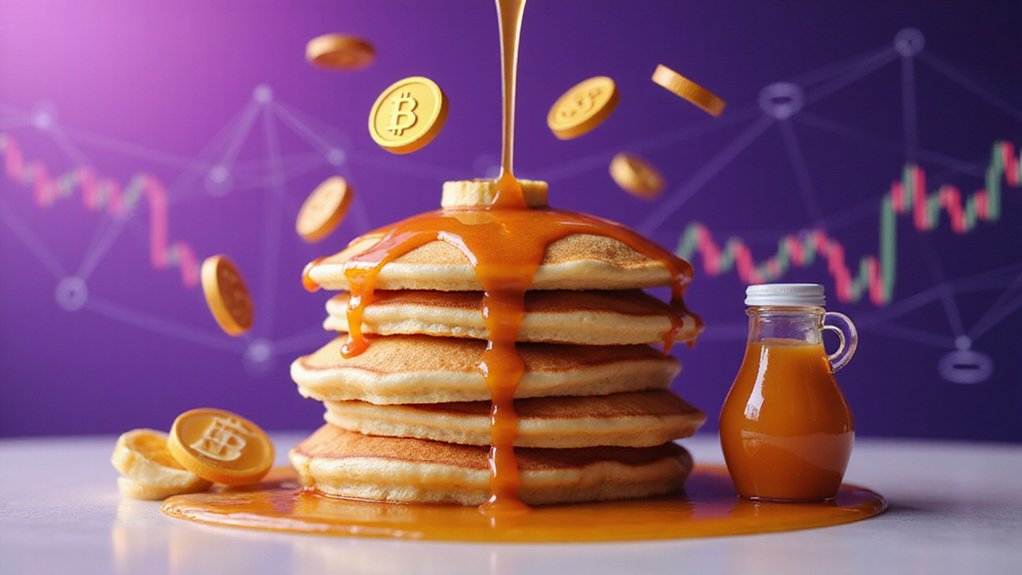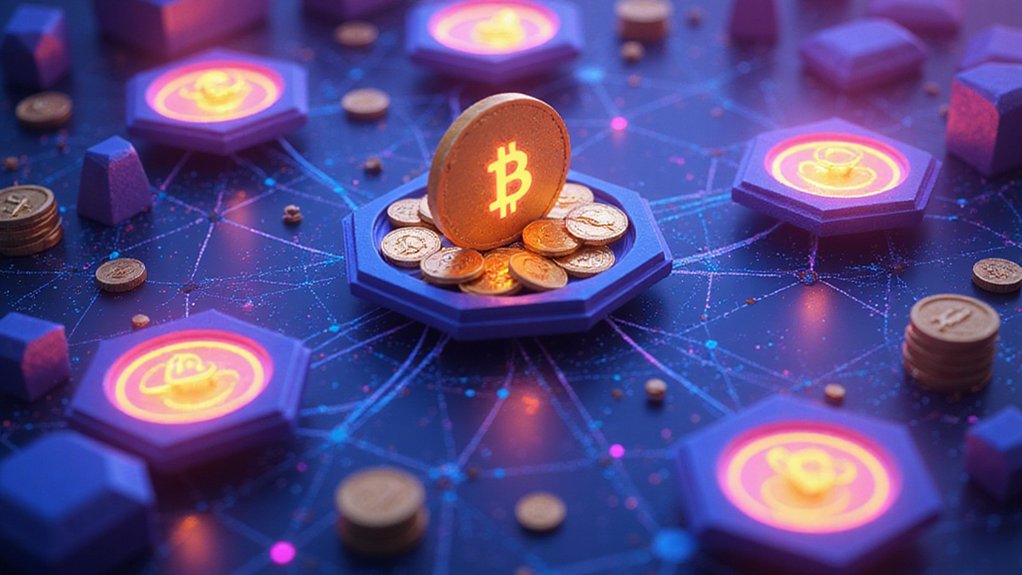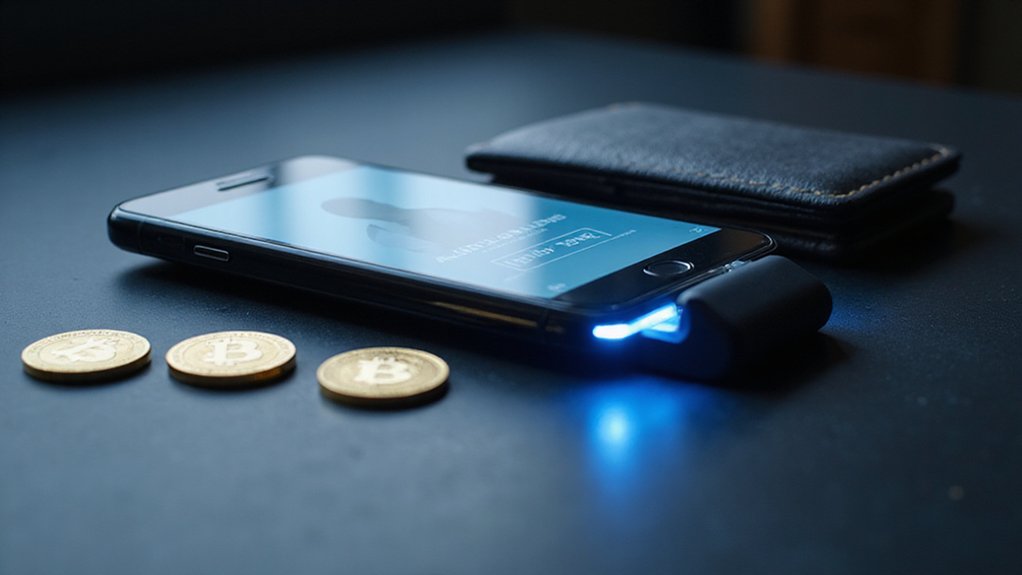PancakeSwap stands as BSC’s dominant decentralized exchange, operating across eight blockchains with $1.62 billion in locked value. Its non-custodial AMM model enables permissionless token swapping via liquidity pools that adjust prices through constant product formulas. Users maintain 100% ownership of funds while engaging with features like staking, farming, and perpetuals. The CAKE token powers governance and rewards, creating a self-reinforcing ecosystem backed by regular security audits. The platform’s multichain strategy continues evolving in fascinating ways.

A veritable juggernaut in the decentralized finance landscape, PancakeSwap has emerged as the preeminent decentralized exchange (DEX) on the Binance Smart Chain while steadily expanding its reach across multiple blockchain networks. Currently operational on eight chains including Ethereum, Polygon zkEVM, and Arbitrum One, the platform’s dominance is particularly pronounced on BSC, where it commands the highest trading volumes and approximately $1.62 billion in total value locked—no small feat in the volatile theater of digital assets.
PancakeSwap dominates the DeFi landscape with multi-chain versatility and commanding market presence—a financial colossus in crypto’s turbulent theater.
At its core, PancakeSwap employs the now-ubiquitous Automated Market Maker (AMM) model, eschewing traditional order books for liquidity pools against which users execute trades. This architecture—non-custodial and strikingly permissionless—allows even novice market participants to list tokens without the bureaucratic gauntlet associated with centralized exchanges. The platform’s liquidity pools enable seamless token swapping directly through users’ wallets without requiring trust in third-party intermediaries. The platform utilizes the constant product formula to automatically adjust token prices based on supply and demand dynamics within each pool. The platform ensures users maintain 100% ownership of funds, unlike centralized exchanges where control is surrendered to third parties. The resulting ecosystem offers an extensive suite of financial instruments: token swaps, liquidity provision with farming incentives, staking mechanisms, perpetual trading, and even more recreational offerings like lottery participation.
CAKE, the platform’s native governance token, serves as both the lubricant and lifeblood of the PancakeSwap economy. Holders wield voting rights on protocol changes (a democratic veneer that most users, one suspects, largely ignore) while also receiving CAKE as rewards for various platform interactions. This tokenomic structure creates a self-reinforcing cycle of participation and value accrual that—when markets cooperate—can be remarkably effective.
Security concerns, the eternal specter haunting DeFi projects, are addressed through regular smart contract audits and the platform’s open-source nature, which invites community scrutiny of its code. The absence of a central controlling entity for user funds represents a philosophical and practical safeguard, though one that places responsibility squarely on users’ shoulders.
PancakeSwap’s extensive product offering, multichain strategy, and substantial community engagement have secured its position as a cornerstone of the DeFi ecosystem—a rare example of a platform achieving both significant adoption and sustained relevance in the notoriously fickle cryptocurrency marketplace.
Frequently Asked Questions
How Secure Is Pancakeswap Compared to Other DEXS?
PancakeSwap stands among the more secure DEXs, having undergone 18+ audits from reputable firms like Certik and Peckshield—comparable to industry leader Uniswap.
Its multi-signature protocols and time-lock features provide additional safeguards that many competitors lack.
While no DEX is impervious to risk (smart contracts being what they are), PancakeSwap’s open-source transparency, non-custodial architecture, and cross-chain flexibility present a relatively robust security profile in the notoriously vulnerable DeFi landscape.
Can I Use Pancakeswap Without Metamask?
Yes, PancakeSwap can be used without MetaMask. Users can access the platform with any wallet that supports BNB Smart Chain, including Binance Wallet, Trust Wallet, and various hardware options.
While MetaMask remains popular, the ecosystem accommodates alternatives for trading and swapping functions.
Note that some advanced features—particularly CAKE token bridging—currently maintain limited wallet support.
As the ecosystem evolves, compatibility with non-MetaMask solutions continues to expand, offering users increasing flexibility in their wallet selection.
What Fees Does Pancakeswap Charge for Transactions?
PancakeSwap implements a tiered fee structure that varies by pool type.
Exchange V2 pools charge a fixed 0.25% fee (0.17% to liquidity providers, 0.0225% to treasury, 0.0575% for CAKE buyback/burn), while V3 pools offer variable rates of 0.01%, 0.05%, 0.25%, or 1%.
StableSwap pools feature customized fee arrangements.
For trading participants specifically, taker fees approximate 0.07% while maker fees hover around 0.02%.
No withdrawal fees apply beyond network gas costs.
How Often Are CAKE Rewards Distributed to Liquidity Providers?
CAKE rewards for liquidity providers operate on a more fluid schedule than their staking counterparts, which follow a regimented Thursday distribution.
While PancakeSwap doesn’t specify a fixed timetable for LP rewards, they accumulate in real-time based on trading activity and fee generation.
This continuous accrual mechanism stands in contrast to the weekly epoch system governing veCAKE staking rewards—a distinction that highlights PancakeSwap’s multi-tiered approach to incentivizing platform participation through carefully calibrated reward structures.
Is Pancakeswap Planning to Expand Beyond the BNB Chain?
PancakeSwap has already expanded well beyond its BNB Chain origins, currently operating across nine major blockchain networks.
Their multichain strategy includes deployments on Arbitrum and integration of advanced trading features like dLIMIT and dTWAP across multiple chains.
With a native bridge facilitating seamless asset transfers between networks, the platform strategically distributes trading risks while tapping into diverse liquidity pools.
This expansion has contributed substantially to their $1.81B TVL and growing market presence.









